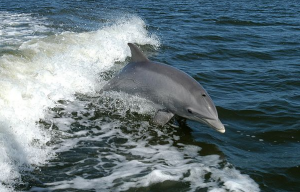 Dolphins on Finding Their Food: DolphIns have approxImaTely 199 TeeTh and are In dIfferenT colors (their body, that is, not their teeth)— WhITe, Black, Grey, Brown, YeLLow and even Pink and Blue!Like human beIngs, DolphIns are MammaLs and Nurse TheIr young wITh TheIr MiLk. They swIm In “schools”, also called “pods”, doIng some ThIngs on TheIr own, Though mosT ofTen are very socIaL – some havIng a shy characTer, and some beIng ouTward and enTerTaInIng, each wITh a unIque personaLITy. Schools can be aT Times Found In The hundreds; Though River DolphIns are found only a handful In number. (SpIlsbury; p. 6)They assIsT each oTher In FIndIng Food, carIng and LookIng ouT For One AnoTher and each oTher’s young. (p. 7)
Dolphins on Finding Their Food: DolphIns have approxImaTely 199 TeeTh and are In dIfferenT colors (their body, that is, not their teeth)— WhITe, Black, Grey, Brown, YeLLow and even Pink and Blue!Like human beIngs, DolphIns are MammaLs and Nurse TheIr young wITh TheIr MiLk. They swIm In “schools”, also called “pods”, doIng some ThIngs on TheIr own, Though mosT ofTen are very socIaL – some havIng a shy characTer, and some beIng ouTward and enTerTaInIng, each wITh a unIque personaLITy. Schools can be aT Times Found In The hundreds; Though River DolphIns are found only a handful In number. (SpIlsbury; p. 6)They assIsT each oTher In FIndIng Food, carIng and LookIng ouT For One AnoTher and each oTher’s young. (p. 7)
DolphIns keep warm because of a layer of Blubber, also called FaT, under The skIn. In contrast, to stay warm, human beIngs have warm foods lIke gInger, blankeTs, Wood Fires, and each oTher! InTeresTIngly, The Bones ThaT make up a DolphIn’s skeLeTon, are Filled wITh FaT and Oil, causIng TheIr bones To be boyoanT gIvIng Them an easIer Time To FLoaT. That is so cool! They move approxImaTely 10-15 km per hr Through The waTer.
Range: Eg. SpoTTed DolphIns have A few hundred Miles / 400 km DIameTer of a Circular Range, TravelIng ~ 45 mIles / 70 km per day. (SpIlsbury; p. 9)
Their buoyant bones allow them to Stay Under waTer abouT 10 mInuTes aT a Time. Then They surface To breaThe aIr Through TheIr blowhole, whIch has a muscular skInflap ThaT closes for when underwaTer (SpIlsbury; p.11). Using EchoLocaTIon for finding Food, they eat SquId, KrIll, anchovIes, and mackeral, (small Fish mosTly). It is InTeresTIng ThaT They eaT JellyFIsh wIThouT beIng harmed by Them – maybe only The small ones! Because They have such good hearIng usIng echoLocaTIon, ThIs sense Is used more Than sIghT for FIndIng Food. RIsso’s eaT mosTly squId. Other River DolphIns eaT Clams, Crabs and Fish. (SpIlsbury; p. 12) UsIng The nasal sacs found jusT behInd The BraIn, The dolphIn sends ouT sound waves called “EchoLocaTIon” ThaT surround and sIze up an objecT, fIgurIng ouT ITs generaL weIghT and sIze and shape, deTermInIng IF IT Is a Good Food Source. (SpIlsbury; pp. 13, 14) SpiLsbury, RIchard and LouIse; A SchooLoF DoLphIns; Illinois: 2004 HeInemann Library; www. HeInemannLIbrary .com)
Q – What is it that causes a Dolphin to have boyount bones? That is, what elements cause their bones to be this way? WHat other sea mammals have boyount bones?
]]>
Charles Darwin coined the term “Natural Selection” which means that as nature changes, the organisms that are able to adapt the quickest are the ones that get to access necessary resources and are able to survive. Organisms that are able to adapt are the ones that can continue to reproduce while those that are not able to adapt will eventually die.
Materials
3 Clear Plastic Cups
Water
Cotton Balls
Vegetable Oil
Instructions
- Fill each cup with water.
- Place a dry cotton ball in the water and observe what happens.
- Dip a cotton ball in oil, making sure that half of the cotton ball remains dry.
- Place it in a second cup and observe what occurs.
- Place a cotton ball in oil, completely covering the entire cotton ball.
- Place it in the third cup and observe what happens.
What’s Happening?When the cotton ball is not covered in oil, it sinks to the bottom of the cup. When it has some oil on it, the oily portion flips to avoid the water but when the cotton ball is completely covered in oil it is able to float. With Ocean Birds, they produce oil that Coats their Feathers and this allows them to float on top of the water. If they did not have this oily coating they would sink like the cotton ball did. If they only had the oily coat on the feathers that were in the water, then they may have a hard time not flipping over. By having all of their Feathers coated in oil, they are able to comfortably and safely float on top of the water until they are ready to dive under to catch fish.
Interested in how animals adapt and evolve over time? Check out these neat online resources!
- http://scienceline.ucsb.edu/getkey.php?key=427
- http://listverse.com/2013/03/25/10-weird-cases-of-incredible-animal-evolution/
And Here is one from our classroom at Science-Lessons.ca: a 52-Card Playing Deck for Ocean Learning, includes 4 several games and completely downloadable for Print and Cut-out – Crazy Starfish! Go Snorkeling! Sea Cluster! and ?Hypothesy?: Ordering: Ocean Science: Ocean Creatures Playing Cards
Also, an updated and more improved version with Teachers Pay Teachers!
]]>